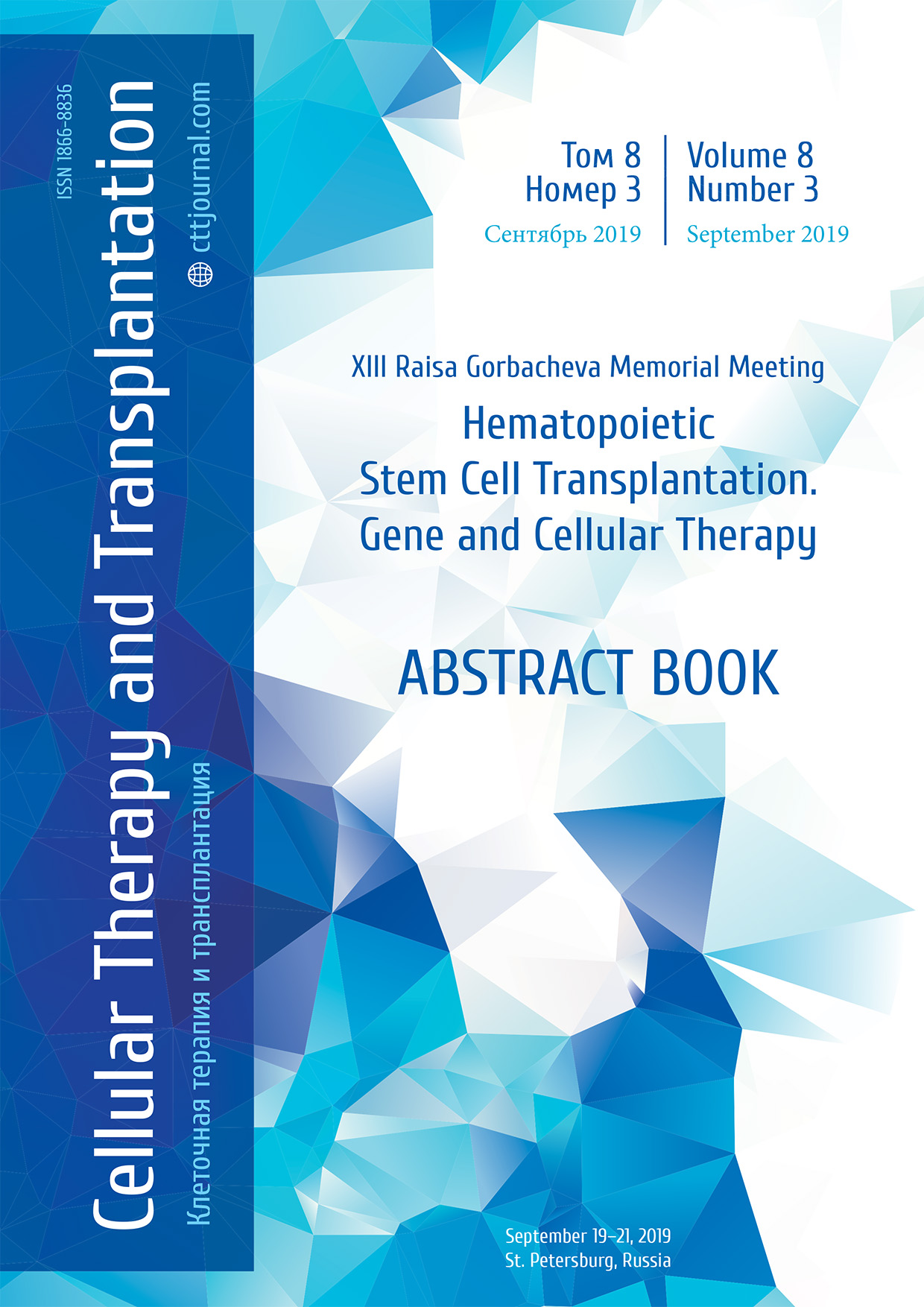The results of allogeneic hematopoietic stem cell transplantation from HLA-haploidentical donor with post-transplant cyclophosphamide regimen in children
Alexandra E. Burya, Kirill I. Kirgizov, Yulia A. Nikolaeva, Ludmila V. Olhova, Veronica V. Konstantinova, Ekaterina A. Pristanskova, Natalia V. Sidorova, Anastasia V. Mezenceva, Oxana L. Blagonravova, Olga A. Filina, Elena V. Skorobatova
BMT Department, Russian Children’s Clinical Hospital at the Pirogov Russian National Research Medical University, Moscow, Russia
Contact: Dr. Alexandra E. Burya
E-mail: burya.a.e@gmail.com
Summary
Hematopoietic stem cell transplantation (HSCT) is a commonly accepted treatment option for high-risk hematological and immunological patients. The selection and availability of a donor is crucial for the success of the treatment. The strategy of using stem cells of a HLA-haploidentical related donor (haplo-HSC) combined with using post-transplant cyclophosphamide has shown the possibility of controlling the graft-versus-host reaction while maintaining the efficacy of HSCT. The purpose of this study was to summarize the experience of haplo-HSCT transplantation of unmanipulated graft from related donors in children with hematological malignancies and immunological pathology with a modified post-transplant cyclophosphamide regimen (PY-CY).
Materials and methods
During the period from 2013 to 2019, 37 haplo-HSCTs were performed in 34 patients at the BMT department of Russian Children’s Clinical Hospital (RCCH) including: acute lymphoblastic leukemia (n=9), acute myeloid leukemia (n=13), juvenile myelomonocytic leukemia (n=7), high-grade lymphoma (n=1), severe combined immunodeficiency (SCID) (n=3), aplastic anemia (n=1). The average age of the patients was 3.5 years (6 month to 14 years). Stem cell sources were bone marrow (BMT, n=34); peripheral blood stem cells (PBSCs, n=3). Patients received a myeloablative regimen: busulfan-based (n=15), threosulfan-based (n=16), full-dose total body irradiation TBI 12 Gray (n=2); lower-intensity conditioning regimens (n=4). For GVHD prophylaxis, PT-CY was given 100 mg/kg on days +3, +4, with rituximab (n=25), calcineurin inhibitors, mycophenolate (n=28); tacrolimus and sirolimus (n=9), abatacept/tocilizumab (n=26).
Results
The median day for the neutrophil engraftment was 21 days. The risk of primary graft failure was 11%, and it was higher in 3/10 patients (30%) treated with busulfan, compared with 1/19 patients from threosulfan-treated group (5.2%). Of 28 patients, 8 relapsed after haplo-HSCT. Complete donor chimerism on day +30 was achieved in 79% patients (n=27). The following post-transplant complications occurred: oral mucositis: grade 1 (n=7), grade 2 (n=14), grade 3 (n=4); neutropenic enterocolitis grade 1 (n=8), grade 2 (n=18), grade 3 (n=5), grade 4 (n=2); toxic hepatitis (n=15), hemorrhagic cystitis (n=6), systemic inflammatory syndrome (n=8), polyneuropathy (n=2), TMA-HUS (n=2). Viremia: cytomegalovirus (n=8), herpes virus type 6 (n=4), adenovirus (n=4) were detected, followed by negative values within short terms. We have also observed acute GVHD with skin rash symptoms of grade 1 (n=5), grade 2 (n=15), grade 3 (n=5), grade 4 (n=2); GVHD with gastrointestinal manifestation of grade 1 (n=7), grade 2 (n=5), grade 3 (n=5), grade 4 (n=2); hepatic GVHD (n=4) of degree 3 of severity; chronic GVHD form (n=9). The transplant-related lethal outcome occurred in one patient with TMA (incidence of 2.9%). Patients with SCID who had respiratory insufficiency of 2nd-3rd degree before conditioning were improved and resolved their complications up to 45-60 days after HSCT. Relapse in children with hematological malignancies was 29% (8 of 28). Relapse-associated mortality was 21% (6 out of 28). Of 34 patients, 27 are currently alive (79%). Median follow-up has been 3.8 years (range 0.6 – 6 years).
Conclusion
Our experience shows that haplo-HSCT with post-transplant cyclophosphamide regimen is effective treatment for high-risk patients with acceptable toxicity and low transplant-associated mortality rate. Early control of infection and antivirus immune response stimulation are the issues to be resolved in further studies. It is still disputable whether threosulfan-based regimen is beneficial for engraftment. High incidence of GVHD requires administration of adaptive supportive care.
Keywords
Hematopoietic stem cell transplantation, HLA-haploidentical, post-transplant cyclophosphamide.


